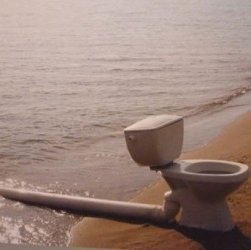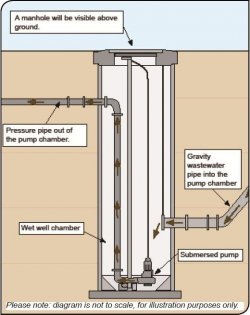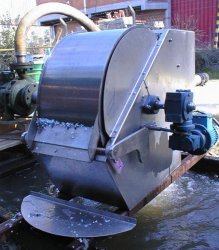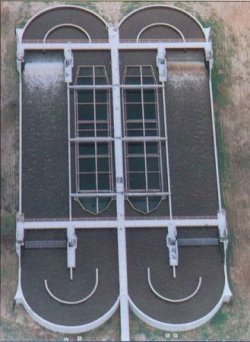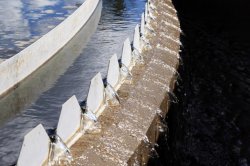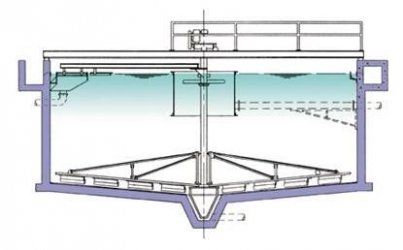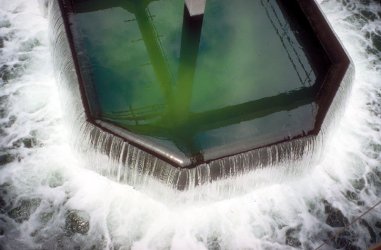BiggTexx
Fish Crazy
[SIZE=10.5pt]Every once in a while you will read or hear a horror story about someone who flushed a live, possibly unwanted, fish down the toilet. I am sorry to break the news to all of the Finding Nemo fans out there, but there is a lot more going on behind the scenes than you would think. The truth is, your little fish is not making it back to the ocean (or a lake or even a stream for that matter), at least in one piece, much less alive.[/SIZE]
[SIZE=10.5pt]It just doesn’t work that way.[/SIZE]
[SIZE=10.5pt]If you are the curious kind, keep reading! While this is not an exact account of every aspect of waste water treatment and may not be the exact same method used across the world, the overall design and principals are the same.[/SIZE]
[SIZE=10.5pt]First, we can start out with a few myths that we can debunk easily at the end of the post.[/SIZE]
[SIZE=10.5pt]Myth #1[/SIZE][SIZE=10.5pt] - Non-native (invasive) fish in local waters are (or can be) caused by flushing a fish[/SIZE]
[SIZE=10.5pt]Myth #2[/SIZE][SIZE=10.5pt] - Flushing a live fish down the toilet would free it into the ocean[/SIZE]
[SIZE=10.5pt]Myth #3[/SIZE][SIZE=10.5pt] - Flushing a dead fish down the toilet is a safe disposal method[/SIZE]
[SIZE=10.5pt]To begin with, if you are on a public sewer system, meaning that your home drains into a public city ‘main’ that the local authorities operate, the chances are that only a few minutes in the system is enough to kill your fish. This will can be from a couple different factors:[/SIZE]
[SIZE=10.5pt]1. [/SIZE][SIZE=10.5pt]Varying water composition.[/SIZE][SIZE=10.5pt] This includes items such as organics, timber, rubber, plastics and ferrous metals, each posing their own dangers and altering the water chemistry. Add to this that any trace amounts of ammonia or pH that you would normally treat before adding to your tank are being added to the mixture since your toilet and faucets use the same source water.[/SIZE]
[SIZE=10.5pt]2. [/SIZE][SIZE=10.5pt]Gravity has limits[/SIZE][SIZE=10.5pt]. In conventional gravity systems, many sewage systems employ the use of ‘lift stations’ which are designed to raise the water levels from a well to a new altitude in order to allow gravity to take over again. Simply stated, water travels through pipes into a deep well and then is pumped upwards closer to the surface before it starts travelling with gravity to a another lift station. Many of these lift stations and/or pumps use a grinding feature in order to help dissolve as many solids as possible. There may be as few as one, or as many as 100 lift pumps before anything can actually reach a treatment facility.[/SIZE]
[SIZE=10.5pt]While it is not likely the fish will survive up to this point, let’s keep walking through in the event that a miracle happened (the fish made it alive up to the bar screen and was able to flop around and over the screen into the collection trough).[/SIZE]
[SIZE=10.5pt]The next step in the system is what is referred to as a ‘race track’. In the race track, water is circulated around a holding tank which contains turns and obstacles in order to decompose (and /or settle) solids and aerate the water to keep beneficial bacteria alive. With the high flow rates of the water and the thickness of the resulting suspended sludge, the water is reminisce of a soupy chocolate milk, although not as pleasant. Here, water and sludge is mixed and aged and as new water is added, older water travels around a baffle and over a weir and onto the next phase of treatment.[/SIZE]
[SIZE=10.5pt]Assuming the fish is still alive at this point and was able to make it over the weir, his next stop would be the clarifier(s). Now, I do have to admit that it is entirely possible for some species of fish to survive inside of the clarifiers. As a matter of fact, the plant that I worked in had a few catfish in each clarifier, one of which was a large 4’ channel hybrid. It should also be noted that they were introduced directly into these tanks and were not flushed! Special precautions had to be taken when operating the clarifiers in order to keep the fish unharmed, but they were around long before I started at the work plant and lasted well through the 6 years I was there and at last check, are still thriving. Clarifier tanks are deep, and some designs can hold upwards of 100,000 gallons.[/SIZE]
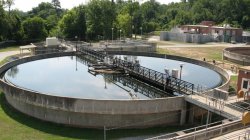
[SIZE=10.5pt]Still assuming our fish has been able to make it through this process, the next step is the chlorine contact basins. This would also serve as the ultimate death trap for a fish. In these basins, the water is mixed with chlorine and allowed to sit in a basin. The average ‘contact time’ is 24 hours. As we all should already know, even trace amounts of chlorine is a death sentence for fish. In these basins, it is not uncommon to see chlorine readings spike to 8.0 ppm or higher, causing an unnatural blue or green tint to the water.[/SIZE]
[SIZE=10.5pt]Once again, as new water is introduced to the tank, older water is forced around a baffle and over another weir where it begins it last leg of a journey before reaching a discharge point. Between the chlorine contact basin and that discharge point there will be an injection of sulfur dioxide gas which then dechlorinates the water. Once the water is dechlorinated, it is discharged directly to a stream, river, lake or even the ocean depending on the treatment facilities location.[/SIZE]
[SIZE=10.5pt]NOTE: (For those of you who may have a private on-site system (septic tanks), please keep in mind that your fish has even less of chance.)[/SIZE]
[SIZE=10.5pt]Now, to debunk those myths![/SIZE]
[SIZE=10.5pt]Myths #1[/SIZE][SIZE=10.5pt] and #2 are relatively easy to do at one time. As we have seen through this post, the chance that a live fish could make it through the entire treatment process is absolutely impossible. So not only can a live fish not make it to the ocean, but a pregnant/holding/fertile fish could not reach a water source in which the eggs/fry would be a viable ‘contaminant’. [/SIZE]
[SIZE=10.5pt]Myth #3[/SIZE][SIZE=10.5pt] may be seen as debatable by some, but it is entirely possible for a diseased fish (live or dead) to pollute the water in a treatment facility and later the receiving water source. While the water treatment plants employ the use of many disinfection methods, it is simply not possible to screen for and treat for every possible disease or bacteria that could be introduced or present in the water. It is also important to note that is illegal in most areas to flush a fish either dead or alive down a toilet for this very reason.[/SIZE]
[SIZE=10.5pt]For those of you who were brave enough to make it through all of the ramblings and scenarios, I would like to pose a question:[/SIZE]
[SIZE=10.5pt]Does this mechanical, biological and chemical process sound even remotely similar, although on a larger scale, to what you may have currently hooked up to your aquarium?[/SIZE]
[SIZE=10.5pt]It just doesn’t work that way.[/SIZE]
[SIZE=10.5pt]Nemo’s Only True Chance[/SIZE]
[SIZE=10.5pt]Image source: http /blogs.ocweekly.com [/SIZE]
/blogs.ocweekly.com [/SIZE]
 /blogs.ocweekly.com [/SIZE]
/blogs.ocweekly.com [/SIZE]
[SIZE=10.5pt]In reality, the chances of your fish making it out of a correctly operated treatment and into the receiving waters is non-existent. The chances that the fish will actually make it alive to the treatment facility is slim itself.[/SIZE][SIZE=10.5pt]If you are the curious kind, keep reading! While this is not an exact account of every aspect of waste water treatment and may not be the exact same method used across the world, the overall design and principals are the same.[/SIZE]
[SIZE=10.5pt]First, we can start out with a few myths that we can debunk easily at the end of the post.[/SIZE]
[SIZE=10.5pt]Myth #1[/SIZE][SIZE=10.5pt] - Non-native (invasive) fish in local waters are (or can be) caused by flushing a fish[/SIZE]
[SIZE=10.5pt]Myth #2[/SIZE][SIZE=10.5pt] - Flushing a live fish down the toilet would free it into the ocean[/SIZE]
[SIZE=10.5pt]Myth #3[/SIZE][SIZE=10.5pt] - Flushing a dead fish down the toilet is a safe disposal method[/SIZE]
[SIZE=10.5pt]To begin with, if you are on a public sewer system, meaning that your home drains into a public city ‘main’ that the local authorities operate, the chances are that only a few minutes in the system is enough to kill your fish. This will can be from a couple different factors:[/SIZE]
[SIZE=10.5pt]1. [/SIZE][SIZE=10.5pt]Varying water composition.[/SIZE][SIZE=10.5pt] This includes items such as organics, timber, rubber, plastics and ferrous metals, each posing their own dangers and altering the water chemistry. Add to this that any trace amounts of ammonia or pH that you would normally treat before adding to your tank are being added to the mixture since your toilet and faucets use the same source water.[/SIZE]
[SIZE=10.5pt]2. [/SIZE][SIZE=10.5pt]Gravity has limits[/SIZE][SIZE=10.5pt]. In conventional gravity systems, many sewage systems employ the use of ‘lift stations’ which are designed to raise the water levels from a well to a new altitude in order to allow gravity to take over again. Simply stated, water travels through pipes into a deep well and then is pumped upwards closer to the surface before it starts travelling with gravity to a another lift station. Many of these lift stations and/or pumps use a grinding feature in order to help dissolve as many solids as possible. There may be as few as one, or as many as 100 lift pumps before anything can actually reach a treatment facility.[/SIZE]
[SIZE=10.5pt]Lift Station Diagram[/SIZE]
[SIZE=10.5pt]Image Source: http /strongerchristchurch.govt.nz [/SIZE]
/strongerchristchurch.govt.nz [/SIZE]
 /strongerchristchurch.govt.nz [/SIZE]
/strongerchristchurch.govt.nz [/SIZE]
[SIZE=10.5pt]Once you finally make it to a treatment facility, the next big obstacle would be a screen (or similar device) that is used to remove as much debris as possible. These devices use various methods to remove the larger debris but the basic principal is the same. Any larger floating or suspended debris are caught on a screen or ladder device and directed to a disposal bin, while the water is able to pass through the screen or down the ladder. Some common items that are frequently removed by the systems include cloth, sticks, leaves, plastics and in some cases, hypodermic needles, packaged drugs (flushed during a police raid perhaps) and yes, even your pet fish.[/SIZE][SIZE=10.5pt]Rotary Screen[/SIZE]
[SIZE=10.5pt]Image Source: http /www.johnsonscreens.com [/SIZE]
/www.johnsonscreens.com [/SIZE]
 /www.johnsonscreens.com [/SIZE]
/www.johnsonscreens.com [/SIZE][SIZE=10.5pt]While it is not likely the fish will survive up to this point, let’s keep walking through in the event that a miracle happened (the fish made it alive up to the bar screen and was able to flop around and over the screen into the collection trough).[/SIZE]
[SIZE=10.5pt]The next step in the system is what is referred to as a ‘race track’. In the race track, water is circulated around a holding tank which contains turns and obstacles in order to decompose (and /or settle) solids and aerate the water to keep beneficial bacteria alive. With the high flow rates of the water and the thickness of the resulting suspended sludge, the water is reminisce of a soupy chocolate milk, although not as pleasant. Here, water and sludge is mixed and aged and as new water is added, older water travels around a baffle and over a weir and onto the next phase of treatment.[/SIZE]
[SIZE=10.5pt]Twin Race Track[/SIZE]
[SIZE=10.5pt]Image Source: www.swansontraining.com [/SIZE]
[SIZE=10.5pt] Saw tooth Weir[/SIZE]
[SIZE=10.5pt]Image Source: http /www.glacierpure.net [/SIZE]
/www.glacierpure.net [/SIZE]
 /www.glacierpure.net [/SIZE]
/www.glacierpure.net [/SIZE][SIZE=10.5pt]Assuming the fish is still alive at this point and was able to make it over the weir, his next stop would be the clarifier(s). Now, I do have to admit that it is entirely possible for some species of fish to survive inside of the clarifiers. As a matter of fact, the plant that I worked in had a few catfish in each clarifier, one of which was a large 4’ channel hybrid. It should also be noted that they were introduced directly into these tanks and were not flushed! Special precautions had to be taken when operating the clarifiers in order to keep the fish unharmed, but they were around long before I started at the work plant and lasted well through the 6 years I was there and at last check, are still thriving. Clarifier tanks are deep, and some designs can hold upwards of 100,000 gallons.[/SIZE]
[SIZE=10.5pt]Waste Water Clarifier[/SIZE]

[SIZE=10.5pt]Image Source: http /www.owasa.org [/SIZE]
/www.owasa.org [/SIZE]
 /www.owasa.org [/SIZE]
/www.owasa.org [/SIZE]
[SIZE=10.5pt]Clarifier Cross Section[/SIZE]
[SIZE=10.5pt]Image Source: http /www.mcnishcorp.com [/SIZE]
/www.mcnishcorp.com [/SIZE]
 /www.mcnishcorp.com [/SIZE]
/www.mcnishcorp.com [/SIZE]
[SIZE=10.5pt]In the clarifier, the water is slowly scraped at the surface by a large squeegee which removes any floating particles from the water. The water is very slowly turned, allowing the suspended particles (referred to as sludge) to sink to the bottom of the clarifier and separate from the water. At the bottom, another set of squeegees direct the settled sludge into traps where it is directed back into the treatment process until it is finally removed via compacting and dewatering, ending up with a cake batter consistency of sludge. Again, as new water is introduced to the tank, older water is forced around a baffle and over another weir before it flows over to the next phase of treatment.[/SIZE][SIZE=10.5pt]Still assuming our fish has been able to make it through this process, the next step is the chlorine contact basins. This would also serve as the ultimate death trap for a fish. In these basins, the water is mixed with chlorine and allowed to sit in a basin. The average ‘contact time’ is 24 hours. As we all should already know, even trace amounts of chlorine is a death sentence for fish. In these basins, it is not uncommon to see chlorine readings spike to 8.0 ppm or higher, causing an unnatural blue or green tint to the water.[/SIZE]
[SIZE=10.5pt]Chlorine Injection[/SIZE]
[SIZE=10.5pt]Image Source: http /www.edwardsaquifer.net [/SIZE]
/www.edwardsaquifer.net [/SIZE]
 /www.edwardsaquifer.net [/SIZE]
/www.edwardsaquifer.net [/SIZE][SIZE=10.5pt]Once again, as new water is introduced to the tank, older water is forced around a baffle and over another weir where it begins it last leg of a journey before reaching a discharge point. Between the chlorine contact basin and that discharge point there will be an injection of sulfur dioxide gas which then dechlorinates the water. Once the water is dechlorinated, it is discharged directly to a stream, river, lake or even the ocean depending on the treatment facilities location.[/SIZE]
[SIZE=10.5pt]NOTE: (For those of you who may have a private on-site system (septic tanks), please keep in mind that your fish has even less of chance.)[/SIZE]
[SIZE=10.5pt]Now, to debunk those myths![/SIZE]
[SIZE=10.5pt]Myths #1[/SIZE][SIZE=10.5pt] and #2 are relatively easy to do at one time. As we have seen through this post, the chance that a live fish could make it through the entire treatment process is absolutely impossible. So not only can a live fish not make it to the ocean, but a pregnant/holding/fertile fish could not reach a water source in which the eggs/fry would be a viable ‘contaminant’. [/SIZE]
[SIZE=10.5pt]Myth #3[/SIZE][SIZE=10.5pt] may be seen as debatable by some, but it is entirely possible for a diseased fish (live or dead) to pollute the water in a treatment facility and later the receiving water source. While the water treatment plants employ the use of many disinfection methods, it is simply not possible to screen for and treat for every possible disease or bacteria that could be introduced or present in the water. It is also important to note that is illegal in most areas to flush a fish either dead or alive down a toilet for this very reason.[/SIZE]
[SIZE=10.5pt]For those of you who were brave enough to make it through all of the ramblings and scenarios, I would like to pose a question:[/SIZE]
[SIZE=10.5pt]Does this mechanical, biological and chemical process sound even remotely similar, although on a larger scale, to what you may have currently hooked up to your aquarium?[/SIZE]


